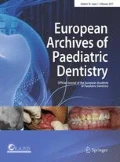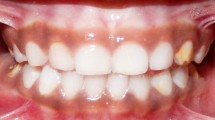Abstract
AIM: To investigate risk factor/s involved in the development of hypomineralised second primary molars and to relate the location of the affected tooth in the dental arches with the timing of the illness/condition incidence. STUDY DESIGN: A cluster sample of 1,000, Iraqi 7–9 year-old children were invited to have their second primary molars examined for demarcated hypomineralised lesions. METHODS: Mothers of 823 children completed a questionnaire-based interview regarding pregnancy and childhood systemic health history. In the clinical examination, the buccal, occlusal and lingual/palatal surfaces of the second primary molar were evaluated for demarcated hypomineralisation lesions by visual examination. RESULTS: A response rate of 82.3% was obtained. Of the children examined, 53 (6.6%) had hypomineralisation defects in at least one second primary molar and were considered as the hypomineralised second primary molar-affected group. Of the total affected teeth (n=83), maxillary molars were the teeth most frequently affected by hypomineralisation throughout all developmental stages (69.9%). Demarcated opacities were the most prevalent lesion type (71.0%). Ninety-four percent of subjects diagnosed with demarcated defects reported various medical conditions possibly associated with hypomineralisation compared with 44% for their non-affected counterparts. Peri-natal medical conditions (45.3%) were the most frequently reported followed by pre-natal and post-natal conditions (24.5%, 9.4%; respectively). STATISTICS: Ill-health during pregnancy, delivery complications, neonatal complications, acute childhood illness, birth weight and duration of breast feeding were significant potential risk factors (p<0.05). The greater the number of health events reported, the higher was the chance of developing the defect. Children who experienced neonatal complications and whose mothers reported pregnancy and birth problems were approximately six times more likely to have the defect than those whose mothers had delivery complications only (80% vs 14.6%) (p<0.001). Also of those children whose mothers did not report delivery complications, but were breastfed for less than six months, of low birth weight and had history of upper respiratory tract infection, the chance of hypomineralised defects was over four times more likely to happen than in those who did not suffer any of these problems (25.8% vs 6.7%) (p<0.01). No statistically significant association was revealed between the time of the illness/condition occurrence and the location of the tooth in the dental arches. CONCILUSIONS: Children with hypomineralised second primary molars had experienced more medical conditions than their unaffected peers particularly during the peri-natal period. No single factor was identified as a potential cause, leaving the aetiology of the defect unclear.
Similar content being viewed by others
References
Al-Dahan ZA, Al-Rawi BA. Determination of fluoride, zinc and lead ions concentrations in primary teeth and drinking water and dental caries experience. Al-Rafidain Dent J 2006; 6(Spec Iss):23–29.
Ahmed NA, Astrom AN, Skaug N, Petersen PE. Dental caries prevalence and risk factors among 12-year old school children from Baghdad, Iraq: a postwar survey. Int Dent J 2007; 57:36–44.
Biggs D, DeVille, Suen E. A method of choosing muhiway partitions for classification and decision trees. J Appl Stat 1991; 18:49–62.
Chaves AMB, Rosenblatt A, Oliveira OFB. Enamel defects and its relation to life course events in primary dentition of Brazilian children: a longitudinal study. Community Dent Health 2007; 24:31–36.
Elfrink MEC, Veerkamp JSJ, Kalsbeek H. Caries pattern in primary molars in Dutch 5-yearold children. Eur J Paediatr Dent 2006; 7: 236–240.
Elfrink MEC, Schuller AA, Weerheijm KL, Veerkamp JSJ. Hypomineralised Second Primary Molars: Prevalence Data in Dutch 5-Year-Olds Caries Res 2008; 42:282–285.
Elfrink ME, Schuller AA, Veerkamp JS et al. Factors increasing the caries risk of second primary molars in 5-year-old Dutch children. Int J Paediatr Dent 2010; 20:151–157.
El-Gilany AH, El-Wehady A, El-Hawary A. Maternal employment and maternity care in Al-Hassa, Saudi Arabia. Eur J Contracept Reprod Health Care 2008;13:304–312.
Fearne JM, Bryan EM, Elliman AM, Brook AH, Williams DM. Enamel defects in the primary dentition of children born weighing less than 2000 g. Br Dent J 1990; 168:433–437.
Ferrini FR, Marba ST, Gavião MB. Oral conditions in very low and extremely low birth weight children. J Dent Child (Chic) 2008; 75: 235–242.
First MARK Technologies. KnowledgeSEEKER user’s guide. Ottawa; Ontario, 1990.
Ghanim A, Morgan M, Mariño R, Bailey D, Manton D. Molar-Incisor Hypomineralisation: prevalence and defect characteristics in Iraqi children. Int J Paediatr Dent 2011; 21:413–421.
Ghanim A, Manton D, Mariño R, Morgan M, Bailey D. Prevalence of Demarcated Hypomineralisation Defects in Second Primary Molars in Iraqi Children. Int J Paediatr Dent 2012; doi: 10.1111/j.1365-263X.2012.01223.
Jälevik B, Norén JG. Enamel hypomineralization of permanent first molars: a morphological study and survey of possible aetiological factors. Int J Paediatr Dent 2000; 10:278–289.
Jälevik B, Klingberg G. Dental treatment, dental fear and behaviour management problems in children with severe enamel hypomineralisation of their FPMs. Int J Paediatr Dent 2002; 12: 24–32.
Kraus BS, Jordan RE. Development and morphology of the primary teeth. In: McDonald RE, Avery DR, editors. Dentistry for the child and adolescent. 8th ed. St. Louis: The C.V. Mosby Co; 2004. p. 51–58.
Leppäniemi A, Lukinmaa PL, Alaluusua S. Non-fluoride hypomineralizations in the first molars and their impact on the treatment need. Caries Res 2001; 35:36–40.
Li Y, Navia JM, Bian JY: Prevalence and distribution of developmental enamel defects in primary dentition of Chinese children 3–5 years old. Community Dent Oral Epidemiol 1995; 23:72–79.
Lin X, Wu W, Zhang C. et al. Prevalence and distribution of developmental enamel defects in children with cerebral palsy in Beijing, China. Int J Paediatr Dent 2011; 21: 23–28.
Lunardelli SE, Peres MA. Breast-feeding and other mother-child factors associated with developmental enamel defects in the primary teeth of Brazilian children. J Dent Child 2006; 73:70–78.
Lygidakis NA, Wong F, Jälevik B. et al. Best clinical practice guidance for clinicians dealing with children presenting with Molar-Incisor-Hypomineralisation (MIH): An EAPD Policy Document. Eur Arch Paediatr Dent 2010; 11:75–81.
Mahoney EK. The treatment of localised hypoplastic and hypomineralised defects in FPMs. N Z Dent J 2001; 97:101–105.
Massoni AC, Chaves AM, Rosenblatt A, Sampaio FC, Oliveira AF. Prevalence of enamel defects related to pre-, peri- and postnatal factors in a Brazilian population. Community Dent Health 2009; 26:143–149.
McKenzie DP, McGorry PD, Wallace CS et al. Constructing a minimal diagnostic decision tree. Methods Inf Med 1993; 32:161–166.
Nation WA, Matsson L, Peterson JE. Developmental enamel defects of the primary dentition in a group of Californian children. J Dent Child 1987; 54:330–334.
Nóren JG, Ranggard L, Klingberg G, Persson C, Nilsson K. Intubation and mineralization disturbances in the enamel of primary teeth. Acta Odontol Scand 1993; 51:271–275.
Rugg-Gunn AJ, Al-Mohammadi SM, Butler TJ. Malnutrition and developmental defects of enamel in 2- to 6-year-old Saudi boys. Caries Res 1998; 32:181–192.
Schanler RJ, Abrams SA. Postnatal attainment of intrauterine macromineral accretion rates in low birth weight infants fed fortified human milk. J Pediatr 1995; 26:441–447.
Seow WK, Brown JP, Tudehope DI, O’Callagan M. Developmental defects in the primary dentition of very low birth weight infants: adverse effects of laryngoscopy and prolonged endotracheal intubation. Pediatr Dent 1984; 6:28–31.
Seow WK. A study of the development of the permanent dentition in very low birth weight children. Pediatr Dent 1996; 18:379–348.
Sivakami M. Female work participation and child health: an investigation in rural Tamil Nadu, India. Health Transit Rev 1997; 7:21–32.
Slayton RL, Warren JJ, Kanellis MJ, Levy SM, Islam M. Prevalence of enamel hypoplasia and isolated opacities in the primary dentition. Pediatr Dent 2001; 23:32–36.
Weerheijm KL, Jälevik B, Alaluusua S. Molar-Incisor Hypomineralisation. Caries Res 2001; 35:390–391.
Weerheijm K, Duggal M, Mejàre I. et al. Judgement criteria for molar-incisor hypomineralisation (MIH) in epidemiologic studies: a summary of the European meeting on MIH held in Athens, 2003. Eur J Paediatr Dent 2003; 4:110–113.
Weerheijm KL. Molar incisor hypomineralization (MIH): clinical presentation, aetiology and management. Dent Update 2004; 31: 9–12.
Whatling R, Fearne JM. Molar incisor hypomineralization: a study of aetiological factors in a group of UK children. Int J Paed Dent 2008; 18:155–234.
World Health Organization. 55th World Health Assembly. Infant and young child nutrition. Geneva, Switzerland: World Health Organization, 2002 (WHA55.25). Internet: http://www.who.int/gb/ebwha/pdf_files/WHA55/ewha5525.pdf (Accessed by 5 December 2010).
Author information
Authors and Affiliations
Corresponding author
Rights and permissions
About this article
Cite this article
Ghanim, A.M., Morgan, M.V., Mariño, R.J. et al. Risk factors of hypomineralised second primary molars in a group of Iraqi schoolchildren. Eur Arch Paediatr Dent 13, 111–118 (2012). https://doi.org/10.1007/BF03262856
Published:
Issue Date:
DOI: https://doi.org/10.1007/BF03262856



